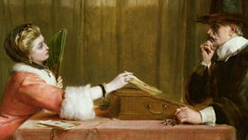
John Callcott Horsley, The Banker’s Private Room Negotiating a Loan, 1870. Image Source: www.oceansbridge.com/paintings/artists
What is the proper payment scheme for commissioned art? The proper payment scheme is the one that you and the artist decide on together. Some artists need the money to buy supplies, others want payment on delivery just like a regular sale. Still others will prefer a deposit and payments along the way. It depends on your budget, the artist’s fiscal needs, and the comfort levels of both parties.
What is the proper way to formalize the deal on payment? What’s the allowable time table for the artist to finish the art? Both parties sign a written contract that states the preferences decided on above, with an additional timeline scheduling payments and delivery dates.
Is it proper to follow up? Did you give this person money? Then hell, yes, it’s proper to follow up. The contract that you wrote will have email addresses, physical addresses, and telephone numbers on it, so following up will be easy. Of course, you’ll want to be diplomatic about any lapses (that is to say, “Just checking in…”instead of “Where’s my damn painting?”—you never know when someone may have tripped over the cat and sprained a wrist), but in the end you’ll have a contract to use as a negotiating tool if things go awry.

John Trumbull, General Washington Resigning His Commission. Image Source: images.fineartamerica.com
Of course, this advice only touches on the financial aspects of commissioning. Readers who have been with me from the beginning will already know that I’m a fan of the book Art/Work by Heather Darcy Bhandari and Jonathan Melber. Even in the absence of kickbacks and nepotism (I’m not related to either of them, I swear), I recommend that you buy a copy of this book and read “Chapter 11: Loans and Commissions,” which outlines in greater detail the ins and outs of commissioning, including a sample Commission Agreement on pages 228-229.
I’m sorry you’re in a muddle with this artist, and I sincerely hope you can work it out, and also that it doesn’t keep you from commissioning work in the future. There are plenty of hard-working and responsible artists who would love to be asked to work on a commission. Good luck.

Openings: not as bad as you think. Image Source: nateinabox.blogspot.com
I am not great in social situations and everyone keeps telling me that if I don’t go to openings I will never get any opportunities. I have a hard time forcing myself to go to shows and when I do I usually end up standing off to the side not talking to anyone. People usually tell me to “just talk to people” but that is much easier said than done. What should I do?
Art openings are like family holidays: you either love them or loathe them. If you’ve got a cool family filled with smart, fun people, the holidays rock. If you have to make small talk with a room full of strangers you see once a year, well…no wonder everyone talks about the suicide rates in December.
As far as I can tell, there are three components to enjoying art openings: don’t think about what you’re wearing, bring a buddy, and go often. Let’s look at each one individually. Your initial goal is to stop feeling self-conscious. It’s hard to forget about yourself in a room full of people who are first and foremost visual; the trick is to remember that everyone there is wondering if they wore the appropriate shoes. Obviously, impressions count and you want to fit in, but stop thinking that everyone is looking at you and assessing your right to be in the room. They’re not. In fact, they might even feel the same way you do: awkward and alone.
Bringing a buddy can be key, especially when you’re starting out. You’ll have a built-in means to chat about the artwork, and then afterward you can go to the bar and gossip about the prices and what sold and who else was there. A buddy will also introduce you to the people he or she knows (if any) and you can start to make some connections within the community in your area. One note of caution: don’t lean too hard on your buddy. You should take the opportunity to split up for at least part of the evening, or else you might find that your friend is the only person you spoke to for three hours. For that, you can stay home in your sweatpants.

My best shoes. Image Source: magtrends.com
Yes, “just talk to people” is easier said than done, but you have to suck it up and start somewhere. Try asking questions, “Do you know who made that very dark video?” at a group show, or “Does the artist always work with toilet paper?” at a solo show. Practice talking to people in the most inane ways: ask the gallerina if openings are always on Fridays or how long the gallery has been in operation. Ask a stranger for the time or where to find a bathroom. It doesn’t really matter what you say: if you are shy and want to change, you have to practice. It’s going to hurt at first, but like most new habits, it gets easier and easier as you go.
The real key to enjoying openings is to go often. You start to see the same people, and then you start to talk to them, and then you make new friends. When you know you’ll see your friends, art openings become a pleasure: each is a little party filled with people that you like and want to see, a three-hour holiday of good cheer to balance every month of hard work and solitude. So put on your best shoes and oil your jaw hinges, and we’ll see you downtown.






